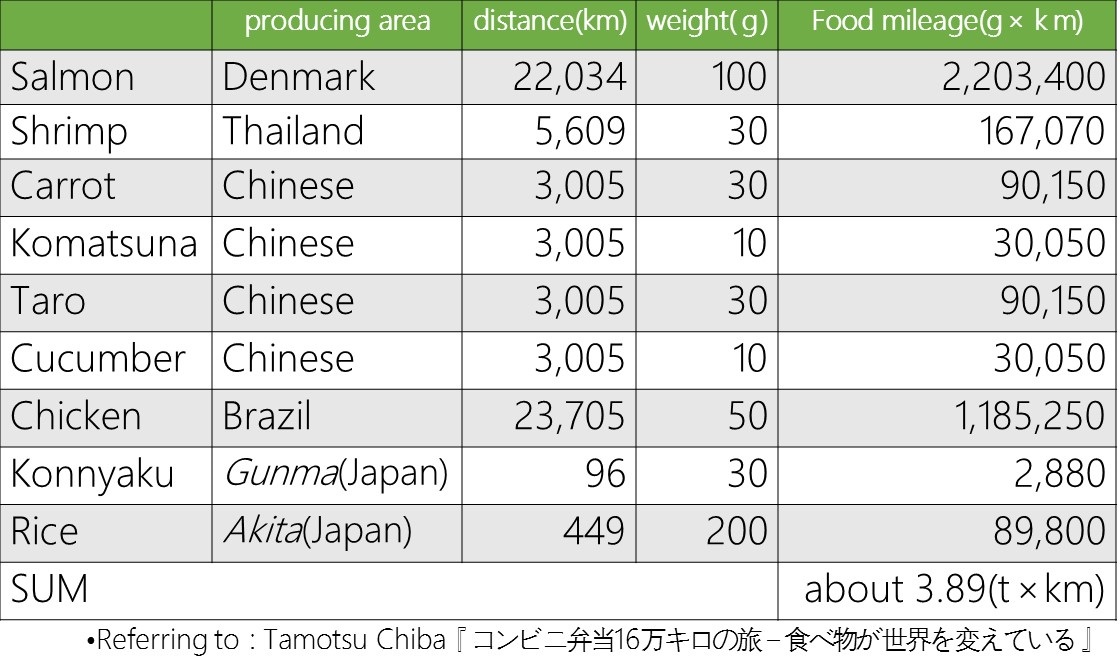Food-mileage

FOOD MILEAGE
Food-mileage, calculated by (a weight of food × a distance of transportation), shows how transporting food affects the environment.Because Japan is an island country, most of imported goods come from countries which are far away from Japan. Also, Japan has low food self-sufficiency rate. Japanese food-mileage for each person is the largest in the world.
Let's calculate food-mileage!
There are meat, fish, or vegetables in Makunouchi lunchbox, a traditional Japanese lunchbox.For example, the Makunouchi lunchbox Jun has in the above cartoon has a salmon, a fried shrimp, komatsuna, carrot, konnyaku, taro, deep-fried chicken, shibazuke, and rice.
This time, Jun bought the lunchbox in Tokyo.

The above Makunouchi lunchbox does not have as many kinds of food as usual, though the distance of transportation is 63,913 km!! This is two-third as long as the equator. It is only 490g, but its food-mileage is 3.89(t×km).
A Discussion about Local Production for Local Consumption
While we stayed Taipei in October, we visited Taipei First Girls' High School. We discussed "Local production for Local consumption" with the students there. Because of the different languages, we were not able to discuss the problem deeply. We have got the following conclusions.
☆100Mile Diet
- Grow fruits and vegetables yourself (or in school).
- Buy local, in-season ingredients.
- Farmers market.
- Tell other people about local production for local consumption.
100Mile Diet
100Mile Diet means eating food made in 100 miles. The students of Taipei First Girls' High School said to us, "For example, you check the production area in supermarkets or stores. If it is over 100 miles from here, you shouldn't buy the food."
1. Grow fruits and vegetables yourself(or in school)
If you grow fruits or vegetables yourself, you can reduce food-mileage. Furthermore, you will be able to understand how food is produced, and your treatment of food will be changed. You can learn about food production if you grow some food.
2. Buy local, in-season ingredients
When we were elementary school students or junior high school students, we had a school lunch which they used local food. Because of it, we know many kinds of vegetables made in our cities or towns.
3. Farmers market
There are many advantages of farmers markets. First, we can reduce food-mileage. Second, you can buy food from farmers not from brokers, so you can buy cheaper food and farmers can get more money. Finally, you don't have to worry about food security. because you know who made the food.
4. Tell other people about local production for local consumption
You cannot do anything if you know nothing. It is also important to tell other people why local production for local consumption is good for the environment,and what food-mileage is.
100Mile Diet means eating food made in 100 miles. The students of Taipei First Girls' High School said to us, "For example, you check the production area in supermarkets or stores. If it is over 100 miles from here, you shouldn't buy the food."
1. Grow fruits and vegetables yourself(or in school)
If you grow fruits or vegetables yourself, you can reduce food-mileage. Furthermore, you will be able to understand how food is produced, and your treatment of food will be changed. You can learn about food production if you grow some food.
2. Buy local, in-season ingredients
When we were elementary school students or junior high school students, we had a school lunch which they used local food. Because of it, we know many kinds of vegetables made in our cities or towns.
3. Farmers market
There are many advantages of farmers markets. First, we can reduce food-mileage. Second, you can buy food from farmers not from brokers, so you can buy cheaper food and farmers can get more money. Finally, you don't have to worry about food security. because you know who made the food.
4. Tell other people about local production for local consumption
You cannot do anything if you know nothing. It is also important to tell other people why local production for local consumption is good for the environment,and what food-mileage is.
We'll introduce GIAHS as an example of sustainable agriculture.


